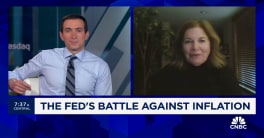Markets shrugged off a weak labor report Thursday morning and opened flat, partly due to optimism following a hefty gain in Asian markets earlier in the day. Half an hour into the session equities then turned higher as two reports gave reason to believe the growth had resumed in the third quarter.
As of 12:30 the S&P 500 was leading the major indexes with a 0.75% gain to 1,004. The Nasdaq has climbed 0.60% to 1,981, while the Dow was trading 0.36% higher at 9,312.
Mortgage News Daily Editor and Analyst Adam Quinones says, "Today's equity rally is a function of short covering in an illiquid summer trading environment. Price movements are magnified by the lack of liquidity"
Well before the open, China’s Shanghai index saw its largest one-day in five months as it moved up 4.52%, setting the state for Hong Kong’s Hang Seng index to close 1.9% higher. In Europe, the FTSE 100 closed 1.57% higher, and Germany’s Dax improved 1.3%.
US data this morning was mixed, but consistent with the theme that specific sectors in the economy are stabilizing while the labor sector continues to decline.
First-time claims for jobless benefits increased by 15k last week to 576,000, and the prior week’s figures were revised up by a few thousand to 561,000. Any number higher than 360k indicates the labor market is bleeding, so the figures suggest that companies continue slash payrolls rapidly to cut costs.
The number of people continuing to receive jobless benefits increased by 2k to 6.241 million for the week ending August 8. The record high of 6.904 million was seen in late June.
“The painful job losses continue, but ― and I know this is not comforting ― the rate of losses is still nowhere near what we saw earlier this year,” noted economist Jennifer Lee from BMO Capital Markets. “At 576k, the number of claimants is well below the recent peak in January of 674k.”
Equity futures were performing well but turned slightly sour after that release, but in the early minutes of trading equities were turning higher, and gains were extended following two reports that suggested a turnaround in the economy.
The Leading Indicators Index (LEI) moved up for its fourth straight month in July witha 0.6% advance, leading the broad gauge of economic data to improve at an annualized pace of +6.2%.
“The overall theme from the data is that the worst of the recession appears to be over,” said Charmaine Buskas from TD Securities.
She added: “Though we continue to see improvements in the leading indicators, there are still headwinds that the U.S. economy must contend with. The labour market will remain a big hurdle going forward and might limit the extent to which the leading indicators can post significant upside.”
Released at the same time, the Philly Fed survey bounced into positive territory as it climbed from -7.5 in July to +4.2 this month. The report is of particular significance as it follows in the footsteps of New York’s Empire State survey, which posted an upside surprise on Monday.
“For the first time since November 2007, all of the survey's broad indicators were positive,” the report said. “Although employment continued to decline among the reporting firms, losses were less widespread this month.”
Deutsche Bank’s chief US economist Joseph LaVorgna said he now believes the nationwide manufacturing survey from the Institute of Supply Management will hit growth mode this month. “Combined with the better than expected readings from the NY Empire Survey earlier this week, we are lifting our ISM forecast by one point to 50.5 from 49.5 as initially projected,” he said.
No more macroeconomic data is scheduled for today, but Fed chairman Ben Bernanke speaks on “A Year of Crisis” tomorrow, which markets could begin bracing for this afternoon.







